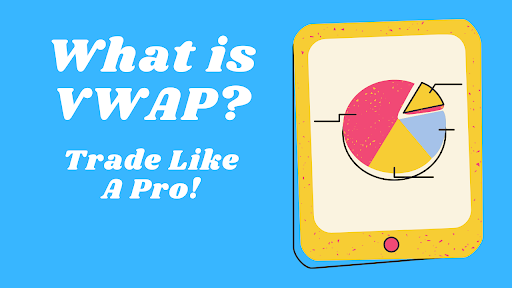What is VWAP? [The Ultimate Guide]
The Value Weighted Average Price (VWAP) is a calculation of the average price of all transactions in a given trading day. The VWAP can be used to measure how closely the current price moves with the volume trend and also provide an indication of how efficiently markets are moving or not.
A stock's VWAP for a given time period provides insight into whether it has been trending upward, downward, or sideways during that time frame.
The market is efficient when prices move in tandem with volume trends and inefficient when they don't. When there is no correlation between volume and price movements, this indicates that market participants' expectations about future events aren't being incorporated into today's prices - meaning there could be potential opportunities for investors to capitalize on these mispriced assets.
What is the formula for calculating a volume-weighted average price?
The volume weighted average is calculated for each day. It starts when the markets open and ends when they close that same day, as it uses intraday data.
VWAP is a trading benchmark which calculates the average price at which all of the market was traded in one session. It's calculated by adding up how much each transaction costs and dividing it to get an averaged number, then multiplying that amount with every trade made for that day or hour.
How to Calculate the Volume-Weighted Average Price
The VWAP indicator is important to know for any trader. It calculates the volume weighted average price of all trades over a given timeframe. Adding it to your chart will complete all calculations for you, so there's no need to do them yourself!
To calculate this on your own, follow these steps:
- The average price traded for the first 5-minute period is calculated by adding high, low, and close then dividing that number by three. This result is multiplied by five minute volume to get PV (price value).
- To get the VWAP value, divide PV by volume for that period.
- To calculate VWAP, create a new column on the spreadsheet for both “cumulative PV” and “cumulative volume.” Add each cumulative value of these two together to produce one total number—the sum of all previous periods' volumes multiplied by their prices divided by the product's price per share times shares traded in that period up until now. Divide this figure from step three (VWAP) with its corresponding total trading values over time as mentioned before to get an accurate average stock market price during any given day.
Volume Weighted Average Price: Is it Important?
The volume weighted average price (VWAP) is the true average of a stock's prices over time. By ignoring its closing value, it gets rid of any lag in movement that may occur during this process. This makes VWAP better suited for intraday trading than moving averages because they rely on historical data points rather than current values to determine their output.
A lot of investors choose VWAP because it has many benefits:
You’ll know when it’s time to sell or buy
An investor using the VWAP tool will not buy a stock when there is an indication to do so. They instead wait for favorable pricing. Someone who pays below the average price of a share won't pay more than that amount either.
VWAP helps investors avoid buying stocks at a higher price. In this way, VWAP allows the investor to make more profit on their investment when they sell its stock later.
It can indicate if the market is bearish or bullish
The price of a stock is determined by the market. The VWAP (volume-weighted average purchase) fluctuates with its bullish or bearish nature, causing an increase in buying pressure during bull markets and vice versa for bear markets.
It is a more effective tool than the moving average
The VWAP is used by pension plans looking to occupy a larger portion of the market. It allows them to take a different position without disrupting the market too much, and with day trading timing is crucial so this lets investors know when it's time to enter or exit markets instead of just following trends in general.
When deciding what stocks to buy, the VWAP is a great indicator. Using it with other trading strategies will provide greater value. The formula can tell you about both long and short positions of any given stock - past, present, or future state of that asset class. It helps investors make more educated trades because they have access to better information than ever before; this combination provides positive reinforcement for traders who want an edge on Wall Street (or anywhere else).
Pros Of VWAP
VWAP ratios can help traders and investors to determine the best price at which they should buy or sell. This is important because it ensures high liquidity, allowing for lower transaction costs and better execution overall.
Using VWAP when trading large numbers of shares is particularly useful. If a trader attempts to buy a large volume of one asset, it could increase its price by artificially inflating the market for this particular stock. Using VWAP ensures that you aren't overinflating the demand for your desired assets.
Reduces the risk
Chartists can measure the variation of price from VWAP using measures like standard deviation. Being an average, traders who use this calculation are less likely to purchase securities at overextended prices as shown in the Envelopes on a Price Chart above.
Support and Resistance Levels
The majority of intraday trading comes from institutions and their algorithms, making VWAP important support or resistance level.
Cons Of VWAP
One issue associated with using the VWAP ratio is that it relies on a vast amount of data points, which can cause lags in its line. This lag causes issues similar to moving average lag and traders/investors only use one-minute or five-minute timeframes.
Large Orders Inaccuracy
Large institutional orders over multiple days have been known to be filled with VWAP as a guide, but this is misleading for large order sizes.
Lagging Indicator
A moving average is a statistical indicator showing where the market has been, but it does not indicate what's next. A lagging indicator, VWAP calculates volume-weighted price for each trade order throughout the day and averages them together to create an index of stock value at any given time which can be used as a reference point when determining whether or not to buy/sell shares.
However, because this data accumulates during trading hours rather than in real-time like other indicators such as RSI (Relative Strength Index), traders should keep in mind that calculations near the end of the session affect their result less than early ones due to the lower amount traded per period.
Trading Volume Fluctuates
Trading is quite active throughout the day, with most of it occurring just after opening and before closing. Because VWAP lags behind on longer-term charts (e.g., 30 or 60 minutes), using a shorter time scale like 1 minute would be better for high-volume securities because signals won't lag as much.
What’s The Difference Between VWAP and a Simple Moving Average?
VWAP and a simple moving average are two indicators that may look similar on a chart, but they actually calculate different things. VWAP is an indicator which calculates the sum of price multiplied by volume divided by total volume, while a simple moving average sum up closing prices over certain periods (such as 10) and then divides it by how many periods there are (10). Volume isn't factored in with either one.
VWAP Strategies
Large institutional investors use VWAP to find a good entry and exit point. When someone wants to sell off a significant position, they try selling at the VWAP or higher because professional traders regularly use several different intraday strategies based on this indicator:
- Investigate market trends.
- Analyze the price's movement to see who is influencing it
- Confirming the support and resistance levels
Conclusion
The volume-weighted average price is a more accurate representation of the current market sentiment than a simple moving average. It can indicate if the market is bearish or bullish and it's an effective tool for determining support and resistance levels.
A VWAP strategy may also be helpful to reduce your risk when trading stocks, as well as help you buy low and sell high. However, there are some disadvantages to using this indicator such as large orders inaccuracy which causes lagging indicators that cannot predict future changes in prices with accuracy.







